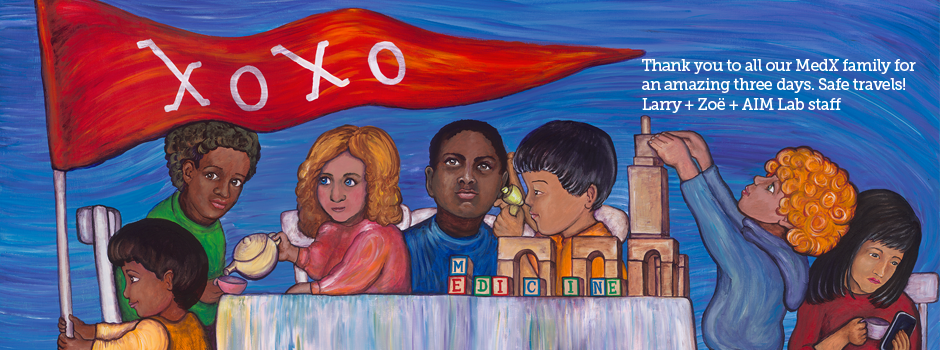
MedicineX is the uber Patients Included medical conference. It grew from seeds planted at conferences like Health 2.0 and Patients 2.0, for which seeds-to-beautiful-flowers gardener credit goes to Dr. Larry Chu and his team from Stanford Anesthesiology AIM Lab, who seem to prestidigitate rabbits out of hats without breaking a sweat. Or the hats. Or the rabbits. MedX – in my opinion, at least – trumps every other Patients Included event by not just including patients, but by putting them front and center throughout the program. In fact, I cannot think of a session that I attended that didn’t have someone who was there primarily as a customer of healthcare (commonly called “a patient”) on the platform, presenting or participating in a panel discussion.
My ePatient socks were knocked off from jump thanks to the opening keynote by Michael Seres and Marion O’Connor on “The New Engaged Patient,” which was the opening keynote on Friday. Michael uses his blog as his personal health record, up to and through a lifetime battle with Crohn’s disease that led to his becoming the 11th patient to ever receive a bowel transplant, and only the 6th to survive that transplant experience. Michael is hilarious, and Marion is exactly the sort of caring brainiac any patient would like bedside as s/he battled a life-threatening illness. MedX hasn’t put the video of that session up on their YouTube channel yet, but keep an eye out for it. The rest of the day played out as a firehose of ePatient awesome, including the first presenter to bring me to tears: Sara Riggare, a brilliant woman who is, among many other things, an engineer and a Parkinson’s patient.
During the panel discussion on “The Self-Tracking Patient,” and my (somewhat sobby) conversation with Sara afterward, was when I fully realized, even though I’d talked about it last year on one of my blogs, that I had been born an ePatient. Well, maybe not born, but them that brung me into the world also brought me to ePatient-cy. I felt my late father, whose Parkinson’s laid him low, and then to rest, over 10 years ago, standing by me as I listened to Sara talk about her own self-tracking and self-advocacy.
My dad was a warrior – literally, a US Navy fighter pilot – and brought that warrior spirit to his battle with Parkinson’s. I’d like to think that Big Mike would be proud of the work I do today to bring sense, and sensibility, to the most human of all sciences: medicine.
The Friday sessions ended with a “What If Healthcare …” panel discussion, conveniently tagged for the Twitter-verse as #whatifhc (click that link for a Symplur transcript of the conversation as it unfolded live). This session is the only one that pressed my buttons in a not-good way, and here’s why: there were a group of white-dude brainiacs, and one not-a-white-dude, on that panel. Don’t get me wrong, I like white dudes. Hell, I’ve married two of ’em (NOT at the same time!). But I found it sort of anachronistic that, as the “dream big” panel on the first day of a Patients Included medical conference on the campus of a major medical school (Stanford Med), the participants on that panel were so very white-dude, with the notable exception of healthcare artist/activist Regina Holliday. Regina herself mentioned the very-not-diverse makeup of the panel during the session. I made the observation on Twitter, as I listened to the panel’s conversation, that healthcare in the US is a great wealth-transfer system … but as a health-transfer system? Not so much. Here’s the first-look video of the session via the MedX YouTube channel:
- Jody Schoger
- Dr. Alan Greene
- Thomas Lee and Audun Utengen, the men behind Symplur
- Gilles Frydman and Roni Zeiger of Smart Patients
- Dr. Bryan Vartabedian
- Katie McCurdy (who’s written a great MedX post you can read here)
- Dr. Rafael Grossmann
- Carla Berg Nelson
- Dr. Deanna Attai
- Dr. Leslie Kernisan
The list of people who I had not known before MedX, and who literally blew me away with their heart and insight? Here’s another random list:
- Joe Riffe
- Emily Bradley (Emily wrote a penetrating piece on how chronic pain affected her MedX experience, read it here)
- Erin Moore
- Liza Bernstein
- Spartacus. No, wait, CHRIS SNIDER. (I think Chris will get the joke there … )
- Amir Dan Rubin – the CEO of Stanford Hospital & Clinics, his master class on quality improvement will inform my hospital-med journo work for years to come
- Dr. Marc Katz (I hadda go to Silicon Valley to meet a terrific doc who practices down the street from me – go figure)
- Terri Wingham
- Dr. Berti Meskó
- Brett Alder
- Dr. Peggy Polaneczky
- Emily Kramer-Golinkoff
- Dr. Christian Assad
- Denise Silber
And the amazeballs of awesome that is Zöe Chu: